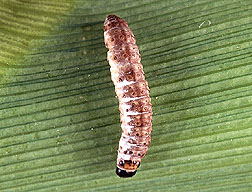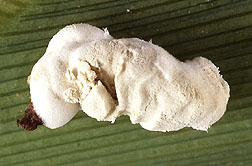Fungus, Corn Plants Team Up To Stymie Borer Pest
The struggle against the European corn borer is a chapter in the never-ending story of farmers trying to save their crops from destruction. This struggle has been tough for farmers managing small acreages, especially those who grow crops with little or no chemical pesticides.
But now two allies may help defeat the corn borer: Beauveria bassiana, a long-established and well-known fungus, and the common corn plant, Zea mays. Agricultural Research Service scientists have found that the fungus can live within the corn plant in a relationship that doesn't hurt the corn but is lethal to many corn borers.
The borer larvae feed on the inside of the cornstalk, weakening the plant and reducing yields up to 30 percent. Weakened stalks fall over more easily, contributing to even greater yield losses.
|
|
In laboratory tests, scientists at the ARS Corn Insects and Crop Genetics Laboratory in Ames, Iowa, observed that up to 97 percent of corn borer larvae were killed when they fed on corn plants colonized with Beauveria fungus. Scientists "seeded" the young corn plants with Beauveria to enhance its natural occurrenceand to coincide with the expected first flight of corn borer moths.
In field trials, the borer mortality rate was lower but still significant, and the Beauveria-treated corn plants had up to 53 percent less borer damage than untreated control plots.
Leslie C. Lewis, an ARS entomologist at Ames, notes that researchers have long known the fungus was lethal to corn borers. "It's Beauveria's relationship with the corn plant that surprised us," he says. "We have found no scientific evidence to date showing that the fungus harms the corn plant."
Lewis says more studies will be needed to learn the exact way in which Beauveria interacts with the plant to protect against corn borers. Meanwhile, farmers who participated in the study say they welcome new developments that enable them to use sustainable practices and keep down costs.
"We'd definitely like to see more of this type of control," says Steven Brunk, a grower near Eldora, Iowa. He farms 480 acres using a corn and soybean rotation with ridge tillage—a cultivation system that uses ridges of soil to reduce erosion by water. He says using biological controls for insects is important in holding down costs.
Near Cumming, Iowa, Dennis McLaughlin farms corn, soybean, oats, and alfalfa. On about 180 acres, he uses practices that control weeds, insects, and erosion with a minimum of tillage and chemicals.
He says Beauveria appeals to him because it is naturally occurring.
|
|
Both farmers are members of the Practical Farmers of Iowa, a group of farmers committed to using sustainable farming practices. Rick Exner, farming systems coordinator for the Iowa State University Extension Service and PFI adviser, says use of Beauveria and other biological controls fits in with the sustainable systems approach.
"In corn production practices, unless you are getting a premium price for a niche market product, it comes down to the bottom line," he says. "The smaller producers can't afford to be extravagant, any more than the larger ones." — By Dawn Lyons-Johnson
Leslie C. Lewis is in the USDA-ARS Corn Insects and Crop Genetics Research Unit, Genetics Laboratory, Iowa State University, Ames, IA 50011; phone (515) 294-8614









